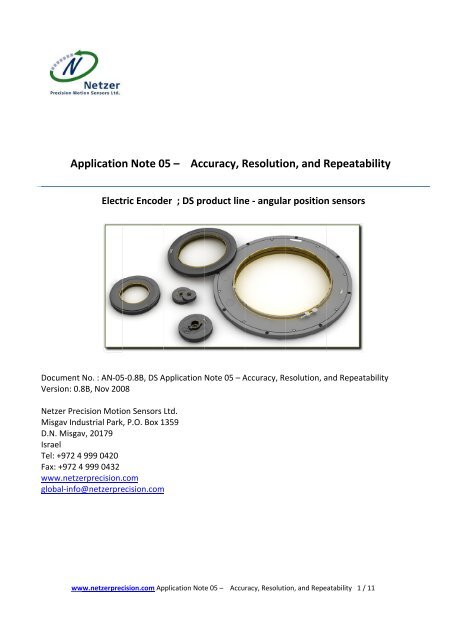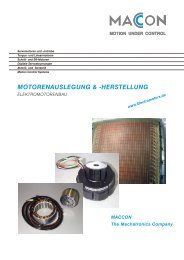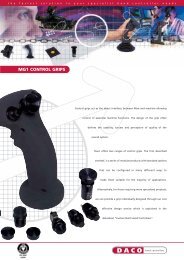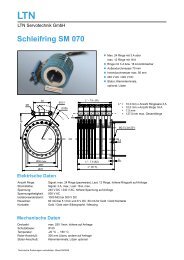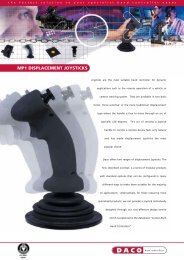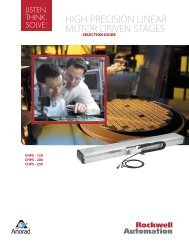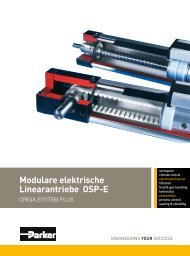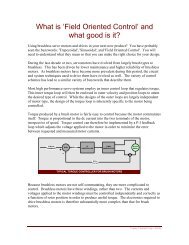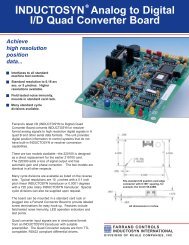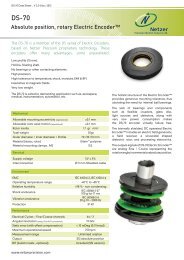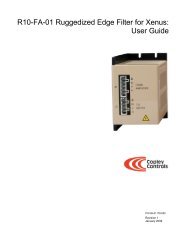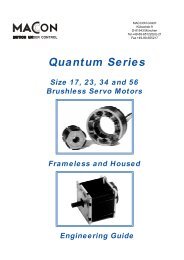AN-05;Accuracy, Resolution, and Repeatability - Netzer
AN-05;Accuracy, Resolution, and Repeatability - Netzer
AN-05;Accuracy, Resolution, and Repeatability - Netzer
- No tags were found...
You also want an ePaper? Increase the reach of your titles
YUMPU automatically turns print PDFs into web optimized ePapers that Google loves.
ApplicationNote <strong>05</strong> – <strong>Accuracy</strong>, Resolutioon, <strong>and</strong> <strong>Repeatability</strong>Electric Encoder ; DS product line‐ angular positionsensorsDocument No. : <strong>AN</strong>‐<strong>05</strong>‐0.8B, DS Application Note <strong>05</strong> – <strong>Accuracy</strong>, <strong>Resolution</strong>, <strong>and</strong> <strong>Repeatability</strong>Version: 0.8B, Nov 2008<strong>Netzer</strong> Precision Motion Sensors Ltd.Misgav Industrial Park, P.O. Box 1359D.N. Misgav, 20179IsraelTel: +972 4 999 0420Fax: +972 4 999 0432www.netzerprecision.comglobal‐info@ @netzerprecision.comwww.netzerprecision.com Application Note <strong>05</strong> – <strong>Accuracy</strong>, <strong>Resolution</strong>, <strong>and</strong> <strong>Repeatability</strong> 1 / 11
1. IntroductionThe Electric Encoder includes fine <strong>and</strong> coarse channels whose output sine/cosine signals aredigitized <strong>and</strong> processed to provide a digital code that represents the absolute position. The finechannel may have from 8 to 128 EC/Rs (Electrical Cycles/Revolution), depending on the diameter,<strong>and</strong> determines the encoder accuracy <strong>and</strong> resolution. The coarse channel has one, three, or sevenEC/Rs, is used solely for the absolute position determination <strong>and</strong> does not affect the accuracy.2. Precision <strong>and</strong> accuracyFigure 1 illustrates the terms accuracy, resolution, <strong>and</strong> repeatability. The orange squares designatemeasured values; the X‐axis designates a variable parameter, such a time. An ideal sensor shouldrepeatedly provide the same output (or digital code), corresponding to the true position – shown bythe dashed red line. <strong>Repeatability</strong> is the extent to which, the same output value, whether correct ornot, is repeatedly obtained for the same measured magnitude in the presence of an outside variable‐ all other variables being constant, it is often referred to as precision. In the case where the variableis time repeatability depends on electrical noise which is inherent in any physical measurement. Thisnoise results from the discrete nature of the electric charge; it has a Gaussian amplitude distribution,constant spectral density, <strong>and</strong> zero average value. <strong>Accuracy</strong> which depends on the differencebetween the time‐averaged measured value <strong>and</strong> the true value is depicted by the dashed red line.<strong>Repeatability</strong>/Precision<strong>Resolution</strong>εFigure 1True value<strong>Accuracy</strong><strong>Resolution</strong> – shown by the small rectangles, is simply the minimal change in the measured valuewhich still result in a discernible output change, it is usually smaller than the accuracy.The output code of the encoder may also be affected by its history through physical memorymechanisms –see Figure 10; for example, thermal expansion/contraction may be partiallyirreversible due to mechanical creep moisture absorption etc, <strong>and</strong> the encoder may provide differentcodes at the same temperature <strong>and</strong> at the same positionFigure 2 illustrates accuracy <strong>and</strong> precision (repeatability) by means of probability distributions ofsuccessive samples of an encoder output with a fixed input X in the presence of electronic noise. TheY value reflects the probability of obtaining a true output value. The blue graph represents excellentaccuracy (zero average error) but low precision (large variance due to large noise), the green <strong>and</strong> redgraphs represent the same accuracy with successively less noise <strong>and</strong> thus higher precision. Thepurple graph represents medium accuracy <strong>and</strong> a precision.www.netzerprecision.com Application Note <strong>05</strong> – <strong>Accuracy</strong>, <strong>Resolution</strong>, <strong>and</strong> <strong>Repeatability</strong> 2 / 11
Figure 2Figure 3Since repeatability also sets a limit to the resolution<strong>and</strong> also cannot be mapped <strong>and</strong> compensated it isultimately the defining factor <strong>and</strong> is synonymous withprecision. Figure 10 is a general model that includesthe non‐idealities which result in the encoder outputerror. The actual encoder is depicted by the red dashedbox <strong>and</strong> its “ideal” portion in the blue box.3. Angular resolutionFigure 3 illustrates graphically the output signals of the Fine‐channel in a rotary Electric Encoder with16 electrical cycles per revolution (EC/R). The angular resolution of the encoder depends on thenumber n of EC/Rs in the Fine‐channel <strong>and</strong> the number N of angular slices to which the electric cyclecan be divided; N depends on the number M of quantization steps in the A/D converter. Altogether,the analog input range of the A/D converter equals Mxh ‐ where h is the quantization step – themaximum number of which is eventually limited by the inherent noise (‐see below).Figure 4‐a illustrates the analog signals in polar coordinates (blue circle) over one electric cycle; eachangular position has an uncertainty defined by the signal‐to‐noise ratio (blurred circle radius divided byR). In reality the quantized values of the sine <strong>and</strong> cosine signals lie on a virtual grid of spacing h. Thegrid includes all possible quantized values but in fact the allowed quantized pairs (blue dots) arefurther restricted to the vicinity of the circle as in Figure 4‐b due to the interdependence of the Sine<strong>and</strong> Cosine where the radius vector to each dot determines its corresponding quantized angle.If the input range of the A/D converter is represented by the diameter of the circle <strong>and</strong> equals 2R thenthe number of quantization levels M equals 2R/h. Unlike the amplitude quantized values the possiblequantized angular increments which lie on the perimeter of the circle are not evenly spaced. Forexample, in region A the spacing ΔΘ between the quantized angles reaches a maximum value of h/Rwhile in region B both larger <strong>and</strong> smaller values are encountered, in region C the maximum spacingwould equal 0.5√2h/R. Note, however that if, by rare chance, the circle exactly crosses the center pointof the square C both digital words will increment simultaneously <strong>and</strong> the angular jump will amount to√2h/R i.e., larger than in region A.www.netzerprecision.com Application Note <strong>05</strong> – <strong>Accuracy</strong>, <strong>Resolution</strong>, <strong>and</strong> <strong>Repeatability</strong> 3 / 11
CosineBRASinhCFigure 4 (a) (b)This is a largely of a theoretical <strong>and</strong> we will assume an average angular increment ΔΘ that equalsh/R. This yields a total of N=2πR/h angular increments, i.e., N=πM. In practice, to allow for in theSine <strong>and</strong> Cosine amplitude uncertainty the input range of the A/D converter should be larger thanthe signal peak‐to‐peak value, therefore, more conservatively, the number of angular increments inone electrical cycle can be assumed to be only 2 times as much as M – the number of signalamplitude levels i.e. N=2M. Taking into account the number n of EC/R the binary angular resolutionwould be log 2 M+ log 2 n+1 bits.The inherent noise density of the Electric Encoder is fixed by design; it is nearly flat up to the encodercutoff frequency f 0 <strong>and</strong> its peak‐to‐peak value is proportional to √ f 0 . In applications where the fullsignal b<strong>and</strong>width not required the noise can be reduced by further low pass filtering or by averaging (‐see below). Thus reducing the cutoff frequency from its typical value of 1000Hz to 250Hz will improve atypical signal‐to‐noise ratio of 4000 to 8000 by a factor of 2 ‐ equivalent to one extra bit. A moreflexible alternative to b<strong>and</strong>width limiting is digital averaging, which provides further advantages, suchas increasing the effective resolution of the A/D converter, <strong>and</strong> reducing the look up table size, asdescribed below.4. Over‐samplingFigure 5 illustrates the spread ofan A/D converter output codesFigure 5corresponding to a constantinput due to its internal noise.The average of the scatteredoutput codes converges at anintermediate valuecorresponding to the inputvalue which is not constrainedto the original grid. In other words, if the input signal has a maximum frequency f 0 <strong>and</strong> is sampled ata rate of 2k f 0 then averaging each k successive samples would still satisfy the Nyquist samplingcriterion while at the same time providing higher resolution. This Over sampling can be explainedintuitively as follows:The output code stream can be regarded as a sampled signal whose b<strong>and</strong>width is proportional to thesample rate. On the other h<strong>and</strong> the variance on the samples values is equivalent to a constantamplitude white noise of the same b<strong>and</strong>width. Therefore averaging – which is equivalent to low‐passfiltering would decrease its amplitude in proportion to the square root of the b<strong>and</strong>width decrease.www.netzerprecision.com Application Note <strong>05</strong> – <strong>Accuracy</strong>, <strong>Resolution</strong>, <strong>and</strong> <strong>Repeatability</strong> 4 / 11
Thus, increasing the number k would decrease the quantization noise by a factor of √k <strong>and</strong> increasethe resolution by log 2 √k bits.Over‐sampling particularly suits the Electric Encoder with its typical 1kHz b<strong>and</strong>width since A/Dconverters can easily sample at least 100 times the required Nyquist rate thus improving quantizationnoise by a factor of √100=10. This would be equivalent to increasing the A/D converter resolution byLog 210 i.e., 3 extra bits e.g. converting a 12‐bit A/D converter into a 15‐bit converter.It is important to notice that from the st<strong>and</strong>point of the A/D converter the encoder noise isindistinguishable from its signal <strong>and</strong> the above analysis does not apply to it, it can only be reduced bylimiting the signal b<strong>and</strong>width. In applications where the full b<strong>and</strong>width of the encoder is not neededthis b<strong>and</strong>width reduction may be implemented by either analog low pass filtering of the input signalsor by increasingly averaging the A/D converter output samples.Also, instead of averaging the A/D converter output codes it is preferable to average the decodedangle obtained from the look‐up table. In fact this provides two potential advantages: 1. Reducing theloading on the CPU. 2. The required look‐up table stays the same <strong>and</strong> fit the A/D converter outputcodes rather than the enhanced resolution obtained by averaging.5. Electric Encoder errors – generalThe error components of the Electric Encoder can be characterized by revolution errors <strong>and</strong> cycleerror. Revolution errors result from imperfect rotational symmetry of the stator <strong>and</strong> rotor relative tothe mechanical rotation axis, such as eccentricity, warp, or tilt. Cycle errors are due to imperfectionsin the Sine <strong>and</strong> Cosine signals <strong>and</strong> comprise harmonics of the EC (electric cycle): 1st harmonic error,2nd <strong>and</strong> the 4th harmonic errors.The number of 1st harmonic cycles in one revolution is the same as the number of the encoderEC/R’s <strong>and</strong> is a result of the sine <strong>and</strong> cosine offset voltages. The dashed circle in Figure 6‐a belong tothe “ideal” signals with no offset, while the blue circle represents the actual measured sine <strong>and</strong>cosine of the electrical angle with the red phasor represents the offset components. It is evident thatat the two electrical angles where the two phasors are nearly collinear the decoded angle will not beaffected by the offset while at the electrical angles where the two are nearly perpendicular the errorwill reach its maximum value of o/P radians, where o is the offset phasor length <strong>and</strong> P is the peakamplitude of the encoder outputs. Thus an offset voltage of 1mV <strong>and</strong> a peak signal of 500mV willresult in an electrical angle error of 1/500=2mRad, which with 32 EC/R will translate into amechanical error of 2/32mRad.Figure 6(b)(a)www.netzerprecision.com Application Note <strong>05</strong> – <strong>Accuracy</strong>, <strong>Resolution</strong>, <strong>and</strong> <strong>Repeatability</strong> 5 / 11
Figure 7‐a illustrates the error graph of the DS‐58 with 32 EC/R without offset compensation,Figure 7‐b shows the residual error after offset compensation which comprises the revolution error<strong>and</strong> the 4 th harmonic error ‐ which repeats four times per EC superimposed on it. This error is relatedto the physics of the encoder <strong>and</strong> can be compensated by introducing a 3rd order Taylor term in thegain curve of the sine <strong>and</strong> cosine. Otherwise it depends on the encoder type <strong>and</strong> is repeatable fromunit to unit.The corresponding offset <strong>and</strong> Taylor compensated error graph is shown in Figure 7‐c where therevolution error, but no 2nd harmonic cycle error is noticeable. A 2nd harmonic error could resultfrom unequal amplitudes of the digitized sine <strong>and</strong> cosine signals, as in Figure 6‐b, <strong>and</strong> from theirimperfect quadrature relation. However, it is avoided by preserving the inherent near ideal amplitudematching of the Electric Encoder, e.g. by using highly matched gain resistors (typically 0.01%) in anyfollowing gain stage prior to digitization or by software gain compensation applied to the digitizedsignals.Figure 7‐awww.netzerprecision.com Application Note <strong>05</strong> – <strong>Accuracy</strong>, <strong>Resolution</strong>, <strong>and</strong> <strong>Repeatability</strong> 6 / 11
Figure 7‐bFigure 7‐cwww.netzerprecision.com Application Note <strong>05</strong> – <strong>Accuracy</strong>, <strong>Resolution</strong>, <strong>and</strong> <strong>Repeatability</strong> 7 / 11
6. Temperature dependenceThe stability of the Electric Encoder output over temperature is a result of its holistic nature, whichmakes it nearly unaffected by thermal expansion, <strong>and</strong> on the common electronic channel forprocessing both Sine <strong>and</strong> Cosine. Residual temperature effects are partly due to slight output offsetvariations – see Figure 8.Figure 8Figure 9 illustrates a typical output angle variation vs. temperature of a premium DS‐58 encoder withits rotor <strong>and</strong> stator clamped to a base plate to which the temperature sensor is attached as well. Aclose look reveals some irregularities around 35°C, which are due to the relatively fast temperaturecycling which results in water condensing inside the encoder, as its cold inside lags the hotter,relatively vapor rich, ambient when going from low to high temperatures. An even fastertemperature cycling, or larger thermal inertia of the mounting plate, could result in an apparenthysteresis (a further separation of the forward <strong>and</strong> backward curves) since the encoder <strong>and</strong> thetemperature sensor may not be at the same temperature, depending on the location of thetemperature sensor <strong>and</strong> the temperature slew rate.Figure 9www.netzerprecision.com Application Note <strong>05</strong> – <strong>Accuracy</strong>, <strong>Resolution</strong>, <strong>and</strong> <strong>Repeatability</strong> 8 / 11
7. Phase behaviorSince capacitance can only be measured using time‐varying voltages the raw signal in the ElectricEncoder is an amplitude‐modulated carrier, which is internally processed by two synchronousdemodulatorsfollowed by low‐pass filters to provide DC sine <strong>and</strong> cosine outputs. The cutofffrequency is determined by the carrier frequency <strong>and</strong> is highly flexible, it is limited by the internallygenerated noise, which sets a limit to the resolution, <strong>and</strong> is proportional to the square root of thecutoff frequency. In the st<strong>and</strong>ard DS encoders the cutoff frequency is 1kHz ‐ sufficient for mostapplications.Figure 10 illustrates the gain (red) <strong>and</strong> phase angle (blue) of the st<strong>and</strong>ard 1 kHz filter on alogarithmic frequency scale. Figure 11 shows the nearly linear dependence of the phase inside thepass b<strong>and</strong> on a linear frequency scale. The encoder output frequency which equals the rotationspeed (in revolutions/second) times the number of EC/Rs determines the electrical phase angle ofthe output signals, but the mechanical phase angle equals the electrical phase angle divided by thenumber of EC/Rs. It follows that the mechanical phase angle is practically dependent on therotation speed <strong>and</strong> on low pass filter regardless of the number of EC/Rs.Figure 10In other words, if the numbers on the frequency axis can also be interpreted as the number of shaftrevolutions‐per‐second . For example, the phase shift is ‐24º at a signal frequency of 200 Hz; it isalso ‐24º mechanical degrees at 200 revolutions per second ‐ irrespective of the number of EC/Rs.This is valid where the curve is linear which is, by definition, the useful frequency range.www.netzerprecision.com Application Note <strong>05</strong> – <strong>Accuracy</strong>, <strong>Resolution</strong>, <strong>and</strong> <strong>Repeatability</strong> 9 / 11
Figure 118. Latency <strong>and</strong> dynamic errorAn ideal linear‐phase is equivalent to a pure time delay, or latency; in the Electric Encoder thephase is linear only over a portion of the frequency range, for this reason the respective stepresponse shown in Figure 12 is distorted as evidenced by the overshoot, besides rejection of thehigh frequency components. The practical result is a dynamic error which is proportional to theproduct of the angular speed <strong>and</strong> the latency. which is about for a 1 kHz filter.Although the dynamic error of 600 μSec may result in a dynamic error which is significantly abovethe static error it is irrelevant except in rare applications, since other time constants such as motor<strong>and</strong> inertia dominate the dynamic loop behavior.Figure 12www.netzerprecision.com Application Note <strong>05</strong> – <strong>Accuracy</strong>, <strong>Resolution</strong>, <strong>and</strong> <strong>Repeatability</strong> 10 / 11
9. General error modelFigure 13 shows the various factors that affect the accuracy of the electric encoder (<strong>and</strong> any sensor,in general). The dashed blue box represents the “ideal” encoder while the red dashed boxrepresents the actual encoder. f 1 (Θ) represents all deterministic errors i.e., errors that can becalibrated out, either by offset compensation, Taylor correction, or eventually mapping. Most of thetemperature induced error is deterministic <strong>and</strong> can in principle be compensated if the encodertemperature is known, indirect temperature effects such as water condensation are nondeterministic. Similarly electronic noise is non deterministic <strong>and</strong> can only be reduced by restrictingthe signal b<strong>and</strong>width.The dynamic error results from the inherent signal delay <strong>and</strong> is proportional to the speed as such itcan be compensated to some degree.TemperatureSecondary effectsf(T)Electronic noiseInput ΘEncoderLP filterA/DCFigure 13f 1 (Θ)Dynamic errorwww.netzerprecision.com Application Note <strong>05</strong> – <strong>Accuracy</strong>, <strong>Resolution</strong>, <strong>and</strong> <strong>Repeatability</strong> 11 / 11


